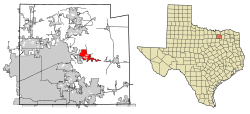Princeton, Texas facts for kids
Quick facts for kids
Princeton, Texas
|
|
|---|---|

Sunrise in Princeton, Texas
|
|

Location within Collin County and Texas
|
|
| Country | United States |
| State | Texas |
| County | Collin |
| Incorporated | May 1912 |
| Area | |
| • Total | 10.155 sq mi (26.301 km2) |
| • Land | 10.098 sq mi (26.154 km2) |
| • Water | 0.057 sq mi (0.148 km2) |
| Elevation | 587 ft (179 m) |
| Population
(2020)
|
|
| • Total | 17,027 |
| • Estimate
(2023)
|
28,027 |
| • Density | 2,780/sq mi (1,072/km2) |
| Time zone | UTC–6 (Central (CST)) |
| • Summer (DST) | UTC–5 (CDT) |
| ZIP Code |
75407
|
| Area code(s) | 214, 469, 972, and 945 |
| FIPS code | 48-59576 |
| GNIS feature ID | 2411493 |
| Sales tax | 8.25% |
Princeton is a city in Collin County, Texas, United States. In 2020, about 17,000 people lived there. By 2023, the city's population grew to an estimated 28,000 people.
Contents
History of Princeton
In the late 1870s, two brothers, T. B. Wilson and George Wilson, started farming near where Princeton is today. In 1881, a railroad line was built through their land. People started calling the area "Wilson's Switch."
When the community wanted to open a post office, they found out the name "Wilson" was already taken. So, they chose "Princeton" to honor Prince Dowlin, a local landowner who helped promote the town. The post office opened in 1888.
Princeton's Role in World War II
In 1940, a camp was built west of Princeton. It had 76 cabins and could house up to 400 migrant workers. These workers came to help with the onion and cotton harvests.
During World War II, in February 1945, this camp became a prisoner-of-war camp for German soldiers. These prisoners had been captured during the war. Local farmers paid the prisoners to work on their farms for eight months.
The German prisoners also helped build the City Park. This park was made as a special memorial to honor those who served and died in World War II. You can find the Community Park/WWII P.O.W. Camp at 500 West College Street.
Princeton Onion Festival
Each year, the Princeton Independent School District and the Princeton Lions Club work together to host the Princeton Onion Festival. This big festival started in 2005. It usually happens on the fourth Saturday of April.
Geography of Princeton
Princeton is located in the eastern part of Collin County. It is next to Lowry Crossing on its west side. U.S. Route 380 goes through Princeton. This road leads about 8 miles (13 km) west to McKinney, which is the county seat. It also goes about 8 miles (13 km) east to Farmersville.
The city covers a total area of about 10.155 square miles (26.301 km²). Most of this area is land, about 10.098 square miles (26.154 km²). A small part, about 0.057 square miles (0.148 km²), is water.
Population and People
| Historical population | |||
|---|---|---|---|
| Census | Pop. | %± | |
| 1920 | 500 | — | |
| 1930 | 459 | −8.2% | |
| 1940 | 564 | 22.9% | |
| 1950 | 540 | −4.3% | |
| 1960 | 594 | 10.0% | |
| 1970 | 1,105 | 86.0% | |
| 1980 | 3,408 | 208.4% | |
| 1990 | 2,321 | −31.9% | |
| 2000 | 3,477 | 49.8% | |
| 2010 | 6,807 | 95.8% | |
| 2020 | 17,027 | 150.1% | |
| 2023 (est.) | 28,027 | 311.7% | |
| U.S. Decennial Census Texas Almanac: 1850-2000 2020 Census |
|||
| Race | Number | Percentage |
|---|---|---|
| White (NH) | 7,605 | 44.66% |
| Black or African American (NH) | 2,535 | 14.89% |
| Native American or Alaska Native (NH) | 85 | 0.5% |
| Asian (NH) | 598 | 3.51% |
| Pacific Islander (NH) | 8 | 0.05% |
| Some Other Race (NH) | 84 | 0.49% |
| Mixed/Multi-Racial (NH) | 827 | 4.86% |
| Hispanic or Latino | 5,285 | 31.04% |
| Total | 17,027 | 100.00% |
In 2020, Princeton had 17,027 people living in 5,294 households. About 4,282 of these were families. The city had about 1,686 people per square mile (651 per km²). There were 5,494 homes in total.
The people living in Princeton come from many different backgrounds. About 52.2% were White, 15.3% were African American, and 3.7% were Asian. About 31.04% of the population was Hispanic or Latino.
Many young people live in Princeton. About 31.4% of residents were under 18 years old. About 6.9% were under 5 years old. People aged 65 and older made up about 6.3% of the population.
City Finances
In February 2021, a company called Standard and Poor’s changed the city's bond rating. It went from "AA" to "AA−". Another company, Fitch Ratings, also raised the city's bond ratings for 2020, 2021, and 2022 to AA+. These ratings show how financially strong the city is.
Education in Princeton
The Princeton Independent School District serves the city of Princeton. This school district is responsible for the public schools in the area.
Images for kids
See also
 In Spanish: Princeton (Texas) para niños
In Spanish: Princeton (Texas) para niños


